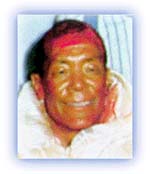Nepal Himalayas
General Info
· Solo Khumbu
· Namche Bazar
· Thyangboche
· Pangboche
· Kalapattar
· Pheriche
· Buddhism in Khumbu
· People: Sherpas
· Mount Everest
· The Quest for Everest
· Early Years
· The 1950s
· Central Nepal
· Mustang
· Jomsom
· People: Thakalis
· Muktinath
· Manang valley
· Bryagu village
· Manang village
· Nyasang Division
· Western Nepal
· Jumla
· Sukhadik
Photo Feature:
· Annapurna region
High Altitude Sickness
Endangered Species
Protected Areas
Yaks
The Yeti Factor

![]()
|
Sherpas on Everest The famed mountaineers from Nepal, the Sherpas, have displayed their superb skill, physical stamina and unmatched spirit on Everest since the very beginning. In fact, they were so successful at high altitude mountaineering that soon it became a common practice for most Himalayan expeditions to employ Sherpas for climbing and ferrying loads up the high mountains. |
Solo Khumbu Valley - the land of the Sherpas. (Download Realplayer) |
 |
| Ang Rita Sherpa Credit: Mahabir Pun |
Sherpas have played quiet but critically important roles in the history of Everest climbing. It is their hardiness, fantastic skill and, above all, a love for their fellow climbers and companions that have won them laurels. The Sherpas, while carrying equipment to high altitude camps, have been known to take risks far greater than those encountered by their employers.
Unfortunately, this has also resulted in a disproportionately high number of Sherpa deaths and injuries on the high mountains. In the 1922 British expedition, seven Sherpa porters were buried under an avalanche on Everest's North Col. Sherpas have accounted for more than one-third of the total deaths on Mt Everest in the first 70 years of everest climbing -- 43 deaths. In the past, the achievements of the Sherpas have been recorded only in footnotes in the annals of mountaineering history. It is only in recent years that Sherpas have been given the rightful credit that they truly deserve.
 |
| Pasang Lhamu. Credit: Mahabir Pun |
Sherpa Tenzing Norgay, along with Edmund Hillary of New Zealand, holds the record of being the first man on top of Mt Everest. A handful of Sherpas have now climbed Mt Everest five times or more. Ang Rita Sherpa holds the incredible record of 9 successes on Mt Everest. Pasang Lyamu was the first Nepali woman to have climbed Everest.
All rights reserved